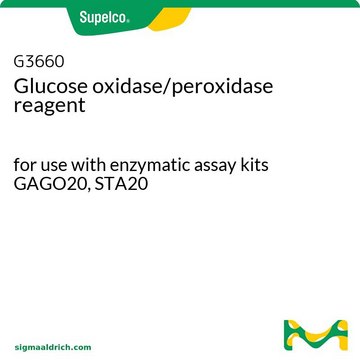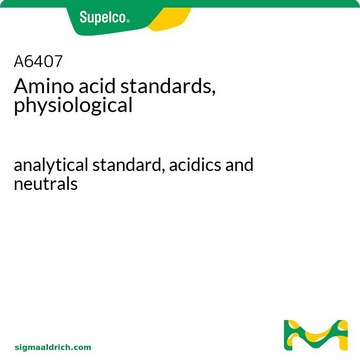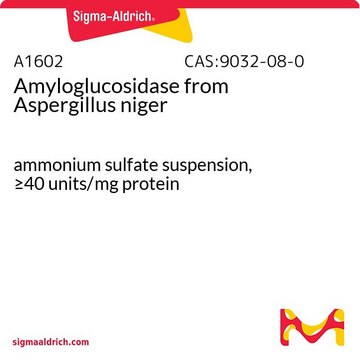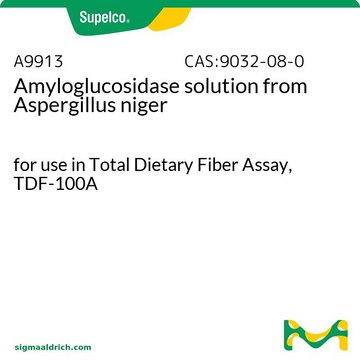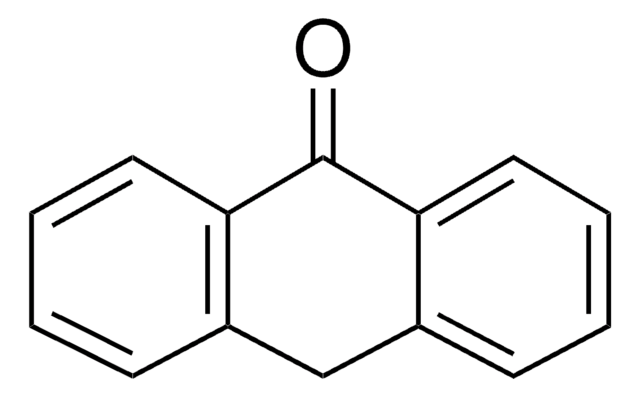P7119
PGO Enzyme Preparation
1 G capsules
Sinónimos:
Peroxidase - Glucose oxidase preparation
Iniciar sesiónpara Ver la Fijación de precios por contrato y de la organización
About This Item
Código UNSPSC:
12352204
NACRES:
NA.54
Productos recomendados
Formulario
powder
solubilidad
H2O: soluble capsule/100 mL at 25 °C, clear, colorless (pH 6.95-7.05)
temp. de almacenamiento
2-8°C
Descripción general
Each capsule contains 500 units of glucose oxidase (Aspergilus niger), 100 purpurogallin units of peroxidase (horseradish), and buffer salts. The reaction produces oxidized o-Dianisidine, which is brown. The intensity of the brown color measured at 425-475 nm is proportional to the original glucose concentration.
Aplicación
PGO Enzymes preparation has been used:
- in diet sampling and chemical analyses
- to determine plasma and follicular fluid glucose levels
- to measure glucose content in fractions of retrograded debranched rice starch
Acciones bioquímicas o fisiológicas
PGO Enzymes are used for the quantitative, enzymatic determination of glucose in aqueous solutions such as serum. The reactions are normally monitored at 425-475 nm utilizing o-dianisidine as a colorimetric substrate. Glucose oxidase methods eliminate the effects of interfering substances. Contents of one capsule includes 100 units peroxidase and 500 units glucose oxidase and buffer salts.
Idoneidad
Tested and found suitable for use in the quantitation of glucose.
Nota de preparación
The PGO enzymes solution is prepared by adding the contents of 1 capsule of PGO enzymes to 100 mL of water in an amber bottle. Bottle should be inverted several times with gentle shaking to dissolve. PGO Enzymes solution should be stored at 2-8 °C. The solution is stable for up to 1 month unless turbidity develops, and for at least 6 months at –20 °C.
Palabra de señalización
Danger
Frases de peligro
Consejos de prudencia
Clasificaciones de peligro
Resp. Sens. 1
Código de clase de almacenamiento
13 - Non Combustible Solids
Clase de riesgo para el agua (WGK)
WGK 1
Punto de inflamabilidad (°F)
Not applicable
Punto de inflamabilidad (°C)
Not applicable
Equipo de protección personal
dust mask type N95 (US), Eyeshields, Faceshields, Gloves
Elija entre una de las versiones más recientes:
¿Ya tiene este producto?
Encuentre la documentación para los productos que ha comprado recientemente en la Biblioteca de documentos.
Los clientes también vieron
G B Penner et al.
Journal of dairy science, 92(4), 1725-1733 (2009-03-25)
This study was conducted to determine the effects of feeding Fermenten (Church and Dwight Co., Princeton, NJ) with or without dietary sucrose on ruminal fermentation, apparent total-tract nutrient digestibility, and nutrient utilization. Eight ruminally cannulated Holstein cows (163 +/- 55
Risheng Ye et al.
Molecular metabolism, 5(7), 437-448 (2016-07-14)
Evidence hints at the ability of β-cells to emerge from non-β-cells upon genetic or pharmacological interventions. However, their quantitative contributions to the process of autonomous β-cell regeneration without genetic or pharmacological manipulations remain to be determined. Using PANIC-ATTAC mice, a
Roni Yair et al.
Journal of dairy science, 100(4), 2651-2659 (2017-01-31)
The objective of this study was to examine the effects of fructose and phosphate (Pi) infusions on dry matter intake by dairy cows to further understand the mechanisms controlling feed intake related to hepatic energy status. We performed 3 experiments
G B Penner et al.
Journal of dairy science, 92(7), 3341-3353 (2009-06-17)
The current study was undertaken to investigate the effect of feeding diets varying in sugar concentration to postpartum transition cows on productivity, ruminal fermentation, and nutrient digestibility. We hypothesized that the high-sugar diet would increase dry matter intake and lactation
Effect of dehydration methods on digested starch fractions of retrograded debranched rice starch
Boonna S, et al.
Journal of Science and Technology, 17(4), 359-368 (2010)
Nuestro equipo de científicos tiene experiencia en todas las áreas de investigación: Ciencias de la vida, Ciencia de los materiales, Síntesis química, Cromatografía, Analítica y muchas otras.
Póngase en contacto con el Servicio técnico